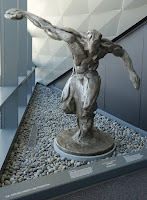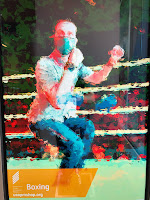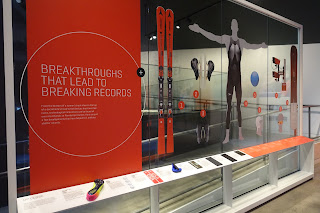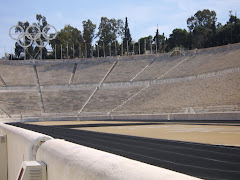Mostly cooped up and grounded from air travel since March 11, how could this wanderlusting five-ringed fan resist a last-minute trek to Colorado Springs for the occasion?
With a new museum membership, airfare, accommodations and writing assignments secured by July 22, a week later I touched down at Denver International Airport and enthusiastically steered my rental car to the foothills of Pikes Peak.
About 90 minutes later, with a highway-side welcome sign for Olympic City USA in view (Colorado Springs earned this nickname over the years), the arrival marked my first visit to old stomping grounds since Christmas 2003 and before that the summer of 1995.
It's been 25 years since my June-to-August internship with USA Wrestling through the U.S. Olympic & Paralympic Committee, and the U.S. Olympic Training Center is now completely overhauled from "back in the day." The military barracks that housed intern classmates and Atlanta Olympic hopefuls are long-gone, and with COVID-19, non-residents are not allowed, which freed more time for the main mission of the 2020 journey: discovering all available to visitors and members at #USOPMuseum.
Built just a few blocks from the USOPC's downtown offices, the USOPM main building and adjacent Flame Caf
é complex run parallel to a stretch of active railroad tracks. I caught my first in-person glimpse of the white rectangle (or "pinwheel" as
described by others) -- coated with a "skin" of more than 8,400 white-coated metal diamonds -- looking east from I-25, and the driveway approach to the building (facing west) puts the museum at the base of a nice vista including the Rocky Mountain range on the horizon.
The next morning I'd learn the site was chosen in a field of derelict warehouses, now cleared for future development. But first, more on the initial views as the sun was setting June 29.
I checked out the exterior on "opening eve" and found rows of empty folding chairs already in place for the Thursday morning ribbon cutting. Near the parking area, a handful of electricians connected wires for newly-installed exterior lights, and the executive chef (also named Nick) at Flam
e pointed out a few details, including a to-be-installed pedestrian bridge linking the museum to a city park just over the rails.
From the outside, I lamented to my girlfriend by phone, the structure made me nervous for an antiseptic experience indoors. The building, for me, lacks the passion of, say, venues designed by Frank Gehry, Zaha Hadid or Renzo Piano. Later research revealed the USOPM architect Diller Scofidio + Renfro also designed a functional yet milquetoast destination "The Shed" experienced last year in Manhattan -- it's beauty proved to be, for this writer, only skin deep. Would USOPM prove to be as soulless inside? Blah!
And I really did not want the USOPM to be "blah!"
Fortunately, during two tours the next day (one as a media guest, the other as a museum member) yielded many great surprises (including the attention given to creating one of the most accessible collections anywhere). Building upon a
published article written for
Around The Rings, here are some detailed notes from the experience:
In a ceremony replacing some typical pomp and circumstance with polite social distancing, the U.S. Olympic & Paralympic Museum officially opened to the public July 30 in Colorado Springs. Beneath the face masks, it seemed attendees were all smiles for an event more than eight years in the making.
"This museum will be an international destination for travelers," said Colorado Springs Mayor John Suthers in a pre-ceremony interview. "I think in the future when people think of [our city], they will want to visit our natural attractions and [USOPM] will be the No. 1 man-made attraction they experience."
Colorado Gov. Jared Polis joined Suthers, Olympic gold medalist Benita Fitzgerald Mosley and Paralympic silver medalist John Register in remarks for a few dozen invited VIPs before taking turns with giant gold scissors to snip blue, yellow, black, green and red ribbons.
By afternoon's end, more than 350 ticketed or annual membership visitors toured the three-level complex, exploring 12 galleries (about 60,000 square feet) featuring 460 artifacts, over 8,600 panels, dozens of interactive kiosks or other hands-on activities.
Through informal conversations, attendees shared universal praise for the museum's Gallery One display of 40 torches spanning 1936 to 2020 and the venue's final exhibit inclusive of 200 Olympic medals, book-ending the tour with rare, complete collections.
Other Olympic and Paralympic medals, diplomas, credentials, uniforms, game-used equipment, personal journals and keepsakes also appear throughout the experience, which permits visitors to explore at their own pace. Special attention was given to provide accessibility and interactivity for all.
For each traditional display, visitors also engage through personalized radio frequency identification (RFID) credentials. Each electronic ticket to the museum -- worn with a USOPM lanyard -- includes a user-assigned QR code that activates automatically as guests approach displays or activities. Visitors also receive a museum-branded stylus for use with touch screens in dozens of locations, starting with a floor-to-ceiling series of U.S. Olympic & Paralympic Hall of Fame digital kiosks.
From the lobby atrium, guests ascend three levels inside a glass-walled elevator featuring panoramic views of nearby Pikes Peak, the region's highest mountain. Steps off the lift, Paralympic and Olympic history feature prominently through all of the galleries and activities.
In the first gallery, I was impressed by a jumbo U.S. map with stations enabling guests to search for Team USA Olympians by geography or other criteria. To progress to the next gallery there's a series of interior ramps that zigzag and gently descend, occasionally peeking down into the aforementioned atrium.
As critical as I am about the architect's passionless interiors, this angular nod to Frank Lloyd Wright's circular, descending and naturally accessible features of his Guggenheim Museum design come to mind, and DS+R is to be commended for implementing input from Paralypians they surveyed to inform the firm's work.
The most interactive space for all ages is an "Athlete Training" section in which visitors may test their physical and mental skills at archery, athletics, alpine skiing, skeleton, goalball and sled hockey. Additionally, as with other interactive stops, the user experiences may be archived to an electronic "locker" later available for online viewing through the museum website.
Team USA athletes appear in video and interactive elements at many stops, notably in a section named "The Lab." Olympian Edwin Moses, for instance, narrates a section in regards to anti-doping regulations in elite sports, and Eric Heiden -- who became a physician following his gold medal feats at Lake Placid 1980 -- describes the physiology of high performance sport.
The history, engineering and technology behind sports equipment also comes to life, especially through a clear-screen video series centered on Michael Johnson's custom-designed gold shoes created for his Atlanta 1996 competitions. For a sample, scroll to the base of this post for a video of the clear-screen video on view in "The Lab."
Guests also experience a simulated athlete stadium portal march into the opening ceremonies and view a 10-minute film produced by NBC highlighting the emotional valleys and peaks experienced by Team USA Olympians (not quite a new take on "the thrill of victory and the agony of defeat" but close).
While the museum includes hundreds of very specific details, some displays paint broader strokes while acknowledging challenges for the Olympic Movement and Olympism. American athlete-turned-IOC president Avery Brundage's controversial decisions related to preventing a boycott of the 1936 Games, for instance, are touched delicately in his Hall of Fame bio and a wall-sized timeline of Olympic milestones presented in the context of world events.
The same timeline glosses over Olympic boycotts, following a separate wall commemorating the 1980 U.S. Olympians who missed the Moscow Games thanks to President Jimmy Carter. On the main timeline, some of the U.S.-hosted Olympiads are briefly described, followed by mentions of LGBTQ-centric topics and doping at the Sochi 2014 Winter Games, as well as the more recent scandal that touched the lives of hundreds of U.S. gymnasts.
This section of the museum also dedicates a wall and glass case of keepsakes contributed by family members for one of the Israeli athlete victims at Munich 1972, but no mention of terrorism at the Atlanta Games nor the event's "largest peacetime gathering in history" status as the Centennial Olympic host. Be sure to read the letter signed by Milwaukee-born Israel Prime Minister Golda Meir.
On a lighter note, a neighboring display features a Sam the Olympic Eagle mascot costume from Los Angeles 1984, and every breakfast cereal box that celebrated U.S. Olympian achievements.
The museum includes a handful of site-specific works of art including a bronze sculpture titled "Olympus Within" created by Olympic fencer and artist Peter Schifrin for the main lobby entry.
The museum's debut "Art of the Olympian" exhibition space features dozens of original paintings and sketches by American artist LeRoy Neiman (1921-2012), who was designated an official artist at five Olympic Games. After viewing his works and one of the artist's studio easels, visitors can strike an athletic pose to create a digital "Neimanized" image.
I hope the curators intend future exhibitions on other "official" Olympic artists including Dallas-based Bart Forbes, who was tapped by the U.S. Postal Service for several five-ringed stamp designs, or Robert Peak, who created the iconic philatelic collection for the Games of 1984 (come to think of it, the museum did not have much in terms of numismatics, official posters, stamps nor pins -- there are a few of each, mind you, but nothing in depth by collector interest).
The USOPM includes a modest event and meeting space featuring one side of the Lake Placid "Miracle On Ice" hockey scoreboard, as well as a nearby dining area named Flame Caf
é, serving a seasonal menu and light breakfast or lunch fare.
"So many museums are static. USOPM has fantastic displays but then you've got these incredible highly technological and interactive elements, like walking in the ceremonies or trying out sports, and the film is incredibly inspiring," said Suthers of his favorite USOPM elements.
Is the USOPM worth a special trip to Colorado Springs? Absolutely!
Did the building's design prove "soulless?" For this amateur architecture critic, yes (I've been dreaming of the passionate treatments Santiago Calatrava, Thomas Heatherwick or other aforementioned architects had a crack at the museum concepts).
But the breadth of USOPM's content, built upon the heart and soul of Team USA athlete feats, more than makes up for mortar and rebar plainness. I look forward to return visits to experience the pedestrian bridge and see how the surrounding neighborhood takes shape.
My other criticism of USPOM regards the technology. Not one but both of my "digital lockers" failed to archive stylus-tapped selections for later online study. Also lost to the tech, my collection of "Neimanized" unsaved after 30 minutes of patience and painstaking poses. First day glitches are to be expected, however -- let's hope they quickly busted the ghost in the machine. The customer service and media relations teams are to be commended for their efforts and time attempting to locate my lost images.
During the media event and exits through the gift shop, I noted six Olympic pin designs related to the museum. There are two versions available at retail (generic logo and museum silhouette), with a couple of "staff only" versions in bronze, silver and gold created as a reward for completing pre-opening pop quizzes.
There was a seldom-seen donor pin created for financial backers who purchased a "diamond" tile on the museum's facade (a fundraising program akin to the bricks at Centennial Olympic Park in Atlanta). These silver (and presumably numbered) diamond-shaped pins may or may not be available for those willing to drop a few grand. Finally, one rare prototype "ticket" pin was given to the No. 1 ticket purchaser on opening day (he was nice enough to let me photograph it).
Some USOPM team members are fluent in pin trading while others are eager to learn, so be sure to bring a pocketful of traders as a conversation starter.
My favorite surprises of the visit: Spotting an athlete-signed cast from an Olympian who broke his arm at one Games to return and win a medal four years later. The credential of an international athlete of the 1932 Lake Placid Games who was given accommodations but denied for competition since the immigration control at New York Harbor misspelled his name. Uniforms and Game-used equipment from several favorite athletes. And the takeaways from playing as goaltender in the Paralympic sport of goalball.
I'd like to see the museum add an Olympic Order to its collection to honor the many U.S. Olympic contributions that earned this rarest of the IOC honors.
They could pair the Order with the pair of blue suede shoes (see photo) donned by an athlete during their opening ceremony march for a head-to-toe in Games gear display.
USOPM tickets are priced at $19.95 to $24.95 with annual memberships starting at $99. The museum is open weekdays 10 a.m. to 5 p.m., Saturdays 9 a.m. to 6 p.m. and Sundays 10 a.m. to 5 p.m., with more information available via USOPM.org.
Top photo by Jason O'Rear via Metalocus and Diller Scofidio + Renfro. All other photos by Wolaver.

























































1 comment:
Such a great collection!!!
Thanks
Engagement Rings adelaide
Pure Envy
Post a Comment